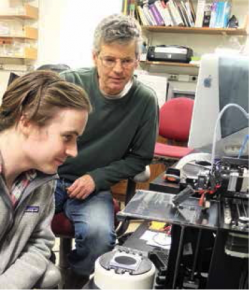Though the waters of Puget Sound are full of beneficial algae, which provide oxygen, food, and shelter for other creatures, it’s the nasty ones that usually make the news. Harmful algal blooms often occur in warm summer waters, and can sicken or kill humans and wreak havoc on shellfish and fishing industries. These blooms are hard to detect and predict, making their management particularly difficult. Now, researchers working with Washington Sea Grant have started to narrow in on harmful algae’s behaviors, and are developing some slick techniques that they hope will lead to much more effective detection and monitoring.

One species of algae is particularly difficult to deal with. Heterosigma akashiwo is a microscopic, swimming phytoplankton whose Japanese names evokes the “golden tides” it creates. This wily species blooms unpredictably and aggressively, poisoning both farmed and wild fish and causing millions of dollars of damage in a given summer.
In addition to a complex lifecycle, the algae have “an enormous genome, the size of yours or mine,” says biologist Rose Ann Cattolico, a professor in the School of Oceanography who works with Washington Sea Grant. These harmful algae have a whole host of clever ways to survive, including the ability to lie dormant on the seafloor when the environment is inhospitable, emerging when conditions improve—a sleek and opportunistic “bioweapon,” as Cattolico puts it. In fact, Elizabeth Tobin, a former graduate student, discovered that the algae could emerge from their sea-bottom torpor within just hours of receiving the right heat and light cues. When they awaken they swim rapidly to the surface to resume photosynthesis, forming massive blooms and poisoning fish and other animals that cross their path.

Armed with this new knowledge about how the harmful algae interact with their environment, scientists are developing better ways to detect when the algae is active, and to predict the poisonous blooms. Oceanography’s Daniel Grünbaum, along with Tobin and graduate student Owen Coyle, have designed a sensor that can track these tiny swimmers automatically, continuously, reliably, and without much expense. Using such technologies as 3D printing, video cameras, and image processing software, the researchers have developed a sensor that is about the size of an inkjet printer cartridge. The sensor leverages the physics of salty water to exploit yet another of the tiny plankton’s unique characteristics: its ability to withstand waters of relatively low salinity. Upon gathering the seawater to be tested, the sensor adds fresh water to the sample. As the two waters naturally separate, due to the greater density of salty water, the golden algae swim up into the fresh water to be counted.
The goal of Grünbaum and colleagues’ work is to increase the effectiveness and decrease the cost of algae sensing technologies: Grünbaum hopes that the sensors will eventually cost less than $500 per unit. While deciphering the ways of toxic algae will continue to be a challenging task, College scientists are making significant headway toward giving resource agencies and aquaculture industries the tools they need to predict harmful algal blooms.
Visit Washington Sea Grant for more information about harmful algal blooms.
Written by: Jen Davison and Eric Scigliano

